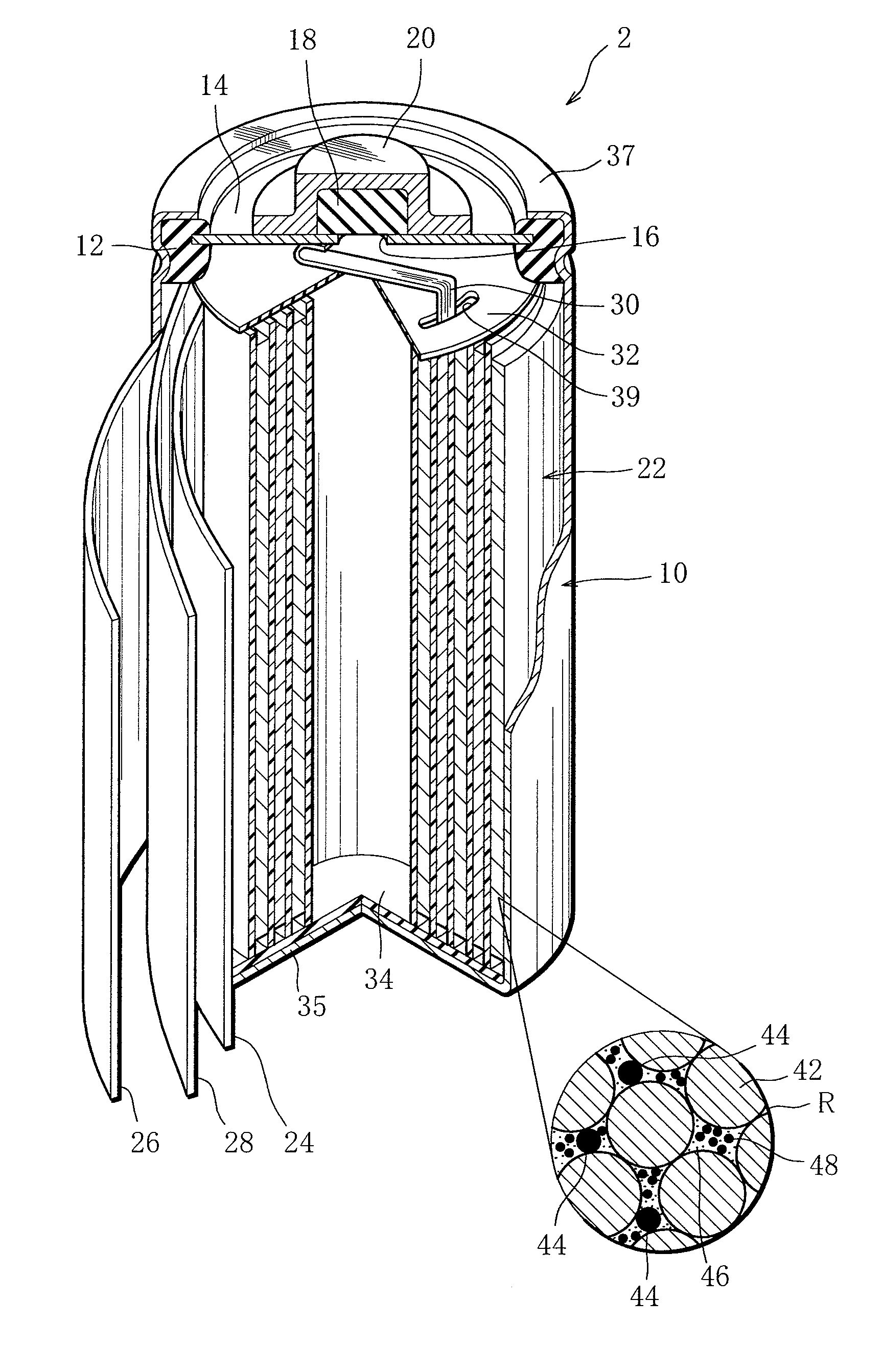Nickel hydride secondary battery
a technology of nickel hydride and secondary batteries, which is applied in the direction of cell components, sustainable manufacturing/processing, and final product manufacturing, etc., can solve the problems of significant decrease in the viscosity of dripping of the negative-electrode mixture slurry, and the remaining capacity decreasing, so as to achieve the effect of increasing the viscosity of the slurry
- Summary
- Abstract
- Description
- Claims
- Application Information
AI Technical Summary
Benefits of technology
Problems solved by technology
Method used
Image
Examples
example 1
(1) Manufacture of Hydrogen Absorbing Alloy and Negative Electrode
[0055]Firstly, a first mixture containing 60 mass % of lanthanum, 30 mass % of cerium, 5 mass % of praseodymium, and 5 mass % of neodymium was prepared. The obtained first mixture, nickel, cobalt, manganese, and aluminum were weighed, and a second mixture having a ratio thereof of 1.00:3.90:0.60:0.40:0.35 at a molar ratio was prepared. The obtained second mixture was melted in an induction melting furnace to form an ingot. Next, heat treatment for heating the ingot at a temperature of 1000° C. under an argon gas atmosphere for 10 hours was performed, and a hydrogen absorbing alloy ingot having a composition of La0.60Ce0.30Pr0.05Nd0.05Ni3.90Co0.60Mn0.40Al0.35 was obtained. After that, the ingot was mechanically pulverized under an argon gas atmosphere to be sieved such that powder made from the hydrogen absorbing alloy particles remaining on between 400 mesh to 200 mesh was sorted out. The particle size distribution of...
examples 2 to 9
[0066]Nickel hydride secondary batteries (batteries b, c, d, e, f, g, h, i) were manufactured in the same manner as the battery a of Example 1, except that, when preparing the negative-electrode mixture slurry, the amount of the thickening agent to be added, the kind of the negative-electrode additive agent to be added, and the amount thereof were set as shown in Table 1.
example 10
[0067]A nickel hydride secondary battery (battery j) was manufactured in the same manner as the battery a of Example 1, except that, when preparing the negative-electrode mixture slurry, a hydrogen absorbing alloy having the and the amount of the thickening agent to be added, the kind of the negative-electrode additive agent to be added, and the amount thereof were set as shown in Table 1.
[0068]In also Examples 2 to 10, the hydrogen-ion exponent (pH) of the negative-electrode mixture slurry was measured. The result is that pH was 8 when the kind of the negative-electrode additive agent is calcium fluoride (CaF2), pH was 8 when the kind of the negative-electrode additive agent is calcium sulfide (CaS), and pH was 8 when the kind of the negative-electrode additive agent is calcium chloride (CaCl2).
PUM
| Property | Measurement | Unit |
|---|---|---|
| pH | aaaaa | aaaaa |
| diameter | aaaaa | aaaaa |
| particle size | aaaaa | aaaaa |
Abstract
Description
Claims
Application Information
 Login to View More
Login to View More - R&D
- Intellectual Property
- Life Sciences
- Materials
- Tech Scout
- Unparalleled Data Quality
- Higher Quality Content
- 60% Fewer Hallucinations
Browse by: Latest US Patents, China's latest patents, Technical Efficacy Thesaurus, Application Domain, Technology Topic, Popular Technical Reports.
© 2025 PatSnap. All rights reserved.Legal|Privacy policy|Modern Slavery Act Transparency Statement|Sitemap|About US| Contact US: help@patsnap.com


